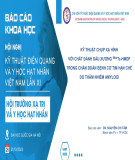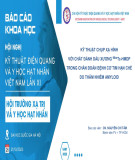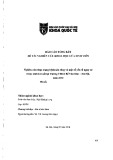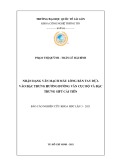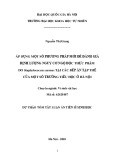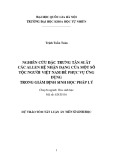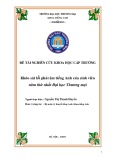
Page 1 of 2
(page number not for citation purposes)
Available online http://ccforum.com/content/12/2/413
Bruel and colleagues nicely demonstrate that the infusion of
2 l cold saline during resuscitation is a feasible, effective, and
safe measure to induce therapeutic hypothermia in out-of-
hospital cardiac arrest [1]. Therapeutic hypothermia was
induced in 33 eligible advanced life support patients before
primary survival was foreseeable, and was continued in 11
patients after intensive care unit admission. The authors
conclude that a large randomised trial should be performed.
The design of future trials on therapeutic hypothermia,
however, seems challenged by the fact that withholding this
treatment in a control arm might be considered unjustifiable
from an ethical point of view. In the prehospital setting, such a
trial would require a large number of study patients to
demonstrate an additional benefit. This is due to the fact that
both a spontaneous decline in body core temperature occurs,
especially in the no-flow and low-flow phase, and that the
overall gain of time (typically around 45 min) may be
considered marginal against the background of most
published data, indicating that target temperatures cannot be
reached until about 6 to 8 hours later [2,3]. Given the
optimistic view that prehospital cooling increases the number
of favourable neurological outcomes from 55% [4] to 60%,
about 750 patients would have to be included in a given
randomised trial.
Nevertheless, although we totally agree with Bruel and
colleagues that the intervention is safe and feasible, and that
a clear biological rationale for the earliest possible induction
of therapeutic hypothermia exists [2-5], we doubt that a
prospective randomised trial on additional prehospital cooling
is feasible and justifiable. We may have reached another
boundary of evidence-based medicine.
Letter
Prehospital therapeutic hypothermia in cardiac arrest:
will there ever be evidence?
Joerg C Schefold, Christian Storm and Dietrich Hasper
Department of Nephrology and Medical Intensive Care Medicine, Charité Universitätsmedizin Berlin, Campus Virchow-Klinikum,
Augustenburger Platz 1, 13353 Berlin, Germany
Corresponding author: Joerg C Schefold, schefold@charite.de
Published: 9 April 2008 Critical Care 2008, 12:413 (doi:10.1186/cc6844)
This article is online at http://ccforum.com/content/12/2/413
© 2008 BioMed Central Ltd
See related research by Bruel et al., http://ccforum.com/content/12/2/R31
Authors’ reply
Cédric Bruel, Jean-Jacques Parienti, William Marie, Xavier Arrot, Cédric Daubin, Damien Du Cheyron,
Massimo Massetti and Pierre Charbonneau
We would like to thank Schefold and colleagues for their
interest in our article [1]. Two issues are discussed in their
correspondence. First, they questioned the ethical rationale
of a randomised study in which the control group would not
receive out-of-hospital therapeutic hypothermia (which is not
yet standard practice) [6]. We believe the findings of our
small pilot feasibility study should not be overinterpreted,
particularly regarding safety issues, because we presented
no control group. For this reason, it is our view that the
potential benefit in terms of neurologic outcome, if any,
should be evaluated in a randomised controlled study.
The second issue raised by Schefold and colleagues is the
small effect size and thus the large sample size required to
demonstrate significant improvements. Recent animal models
by Nozari and colleagues [7] and Zhao and colleagues [8]
demonstrate the benefit on survival if hypothermia is induced
during cardiopulmonary resuscitation. This finding supports
the concept that postresuscitation injury processes begin
immediately after the return of spontaneous circulation, and
that cooling during advanced life support may serve as a
useful therapeutic approach to improve survival.
Although we do not share Schefold and colleagues’ opinion
that the gain of time on cerebral disease is marginal [9], we
agree that the potential improvement would be small, in terms
of clinical outcome. For this reason, a multicentre international
randomised study may be necessary.

Page 2 of 2
(page number not for citation purposes)
Critical Care Vol 12 No 2 Schefold et al.
Competing interests
The authors declare that they have no competing interests.
References
1. Bruel C, Parienti JJ, Marie W, Arrot X, Daubin C, Du Cheyron D,
Massetti M, Charbonneau P: Mild hypothermia during advanced
life support: a preliminary study in out-of-hospital cardiac
arrest. Crit Care 2008, 12:R31.
2. Froehler MT, Geocadin RG: Hypothermia for neuroprotection
after cardiac arrest: mechanisms, clinical trials and patient
care. J Neurol Sci 2007, 261:118-126.
3. Schefold JC, Storm C, Joerres A, Hasper D: Mild therapeutic
hypothermia after cardiac arrest and the risk of bleeding in
patients with acute myocardial infarction. Int J Cardiol 2008.
[Epub ahead of print].
4. Hypothermia After Cardiac Arrest Study Group: Mild therapeutic
hypothermia to improve the neurologic outcome after cardiac
arrest. N Engl J Med 2002, 346:549-556.
5. Storm C, Schefold JC, Nibbe L, Martens F, Krueger A, Oppert M,
Joerres A, Hasper D: Therapeutic hypothermia after cardiac
arrest – the implementation of the ILCOR guidelines in clinical
routine is possible! [Letter.] Crit Care 2006, 10:425.
6. Nolan JP, Deakin CD, Soar J, Böttiger BW, Smith G: European
Resuscitation Council Guidelines for Resuscitation 2005:
Section 4. Adult advanced life support. Resuscitation 2005,
67(Suppl 1):S39-S86
7. Nozari A, Safar P, Stezoski SW, Wu X, Kostelnik S, Radovsky A,
Tisherman S, Kochanek PM: Critical time window for intra-
arrest cooling with cold saline flush in a dog model of car-
diopulmonary resuscitation. Circulation 2006, 113:2690-2696.
8. Zhao D, Abella BS, Beiser DG, Alvarado JP, Wang H, Hamann KJ,
Vanden Hoek TL, Becker LB: Intra-arrest cooling with delayed
reperfusion yields higher survival than earlier normothermic
resuscitation in a mouse model of cardiac arrest. Resuscita-
tion 2008 [Epub ahead of print].
9. Saver JL: Time is brain – quantified. Stroke 2006, 37:263-266.


